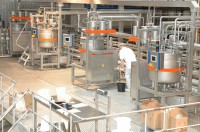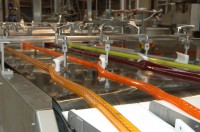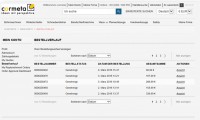SOA People AG
Digitalisation brings benefits for the food products industry
Industry 4.0 is revolutionising the food products industry in unprecedented ways. While some manufacturers were initially hesitant and referred to mechanical engineers and discrete individual production in regard to digitalisation, this scepticism has largely disappeared in the meantime.
Alook at the numerous studies on Industry 4.0 makes one thing perfectly clear: The Internet of Things is seen as an engine for ideas. In addition to start-ups, established manufacturers and brand name food article companies are also eager to participate in order to open up new markets. The related increase required in the flexibility and modularisation of production to accommodate the smallest possible units demands maximised data availability. Since ERP systems store a majority of this data, they play a central role in IoT projects.
Holger Behrens, CEO of the SAP partner company Cormeta AG in Ettlingen, Germany comments, “Today’s consumers demand products personally tailored for them. We already have a number of notable examples of individualisation such as the Katjes Candy Factory with Consumer 3D Printing”. Katjes, the fruit gum manufacturer, has placed 3D printers in a number of its stores that are capable of creating customised sweets from numerous moulds. Recently the company’s online shop was linked up for “self-designed” fruit gums. A similar case is NASA‘s 3D food printers for long-term space missions. The start-up company BeeHex has taken NASA‘s technology further, using 3D printers to “print” pizza, chocolate and small pastries in layers via nozzles. And inventive device manufacturers are already thinking about a combined 3D printer and baking oven.
Digital data for digital processes
Automation is a familiar term for the process manufacturing industry. Many processes have already been automated in recent years, and some are already digitalised. Mr. Behrens explains, “With ERP implementation we have already optimised many digital processes for our food industry customers and additionally automated most of them with intelligent workflow support”.
The focus of these digitalised processes was always the ERP system – at Cormeta this consists of the SAP all-in-one solution known as Foodsprint. Mr. Behrens continues, “Certainly not all of our customers have already implemented the PLM functionalities or automated QM processes and system-aided recipe development. But most have now implemented documentation, batch traceability and in-process controls for HACCP or FDA”.
But it is particularly important in the run-up to digitalisation to also have things like recipe development and quality assurance operating in a software-aided manner in order to bring innovative food products to the market quickly. Mr. Behrens poses the question, “What‘s the point of having a great development department with good ideas if the ideas are already out of date by the time the products they envision reach the market?”.
Particularly against the backdrop of increasing international competition, it is innovative products that are capable of opening and developing new markets. Essential prerequisites for rapid market development are integrated recipe development, individualised production and transparency regarding material and process costs. Mr. Behrens emphasises, “These are the true challenges for medium-sized food products manufacturers. Flexible, individually customised ready-made production requires transpar-ency in regard to all of the processes, and we can help with this”. This expanded flexibility extends to label printing initiated with data from the ERP system which, if required, can even print individual single labels. Mr. Behrens continues, “We can never forget that digitalisation demands digital data, and most of this comes from the master data in ERP systems, PLM, CRM, DMS and the like”.
For instance, PLM and further down the line the affiliated recipe development should be so flexible that new recipes can already be developed by altering existing ones. Functions such as mass alteration or simply copying recipes benefit this. An additional simplification of the work processes results if label data can be sent via communications interfaces directly to a company‘s marketing department or packaging manufacturers. A change in status automatically triggers the generation of the production stock list from a new recipe.
Food producers introducing additive production processes will structure their production in a flexible, modular way. A large-scale bakery for instance will not integrate huge 3D printers to manufacture dough rolls into its process system. Instead it will construct a series of smaller parallel processing units that can be more flexibly equipped and converted more quickly, which is important for small batch sizes. In this way, even the large-scale baker can still supply a particular customer daily with the precise bread rolls needed for the shop. Mr. Behrens predicts, “This is not out of reach anymore. This will soon be reality”. What is already possible for muesli packaging today will soon be possible in a Business-to-Customer context for many food products.
Mr. Behrens notes, “Today‘s consumers have a far greater awareness of where their food products come from. They want to know where something was produced and where the raw materials originated”. A certificate of origin is necessary in order to clearly show consumers where their chips, pasta or schnitzel comes from. And most IT solutions are capable of reproducing such certificates.
From batch tracing to food tracking
In the processing industry decisive roles are played by batch traceability in mass serialisation along with track-and-trace capacity to the customer. The fact that buyers also demand greater transparency today is increasingly relevant for the food products industry and the trade sector.
A modern software solution for the process industry should make data on raw materials and their origins visible as well as traceable. These solutions must also be capable of registering the origin batches arriving to the goods receiving department in different ways, either via data provided by the manufacturer or optionally via inspection of the vendor batches by the goods receiving department itself.
The software should then be able to automatically allocate the received goods to the origin data. Mr. Behrens concludes, “We recommend printing the tracking code onto the packaging, for instance as a QR code. This ensures traceability all the way back to the original producer. This kind of function makes it possible to clearly determine and track a product’s origin”. •





.jpg)
.jpg)
.jpg)